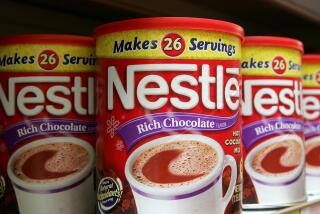Candles With Lead in Wicks Put Children’s Health at Risk; U.S. Considers Ban
- Share via
WASHINGTON — The government is considering a ban on candles containing lead because they could expose young children to the risks of toxic smoke.
Candles with wicks containing lead, many of them imported, are turning up on store shelves despite a voluntary ban by U.S. candle makers, according to a study by the Consumer Product Safety Commission.
Only a small percentage of candles contain lead, but some of those that do can release five times the amount of lead considered hazardous for children younger than 6, the study found.
Since it is hard to tell if a candlewick contains lead, the safety commission said parents should avoid burning any candles with metal wicks near their young children or should just throw the candles away, according to commission spokesman Russ Rader. People can identify this type of candle by looking at the top of the wick for a metal core, which is used for support.
There have been no confirmed cases of children suffering lead poisoning from a candle, but the government is concerned that children could inhale the lead or ingest it after it settles onto surfaces. Children are particularly vulnerable to lead poisoning, which can cause a variety of ailments, ranging from lower intelligence and learning disabilities to seizures and death.
The commission has proposed a ban that would apply to both U.S. candles and imports.
“A ban would allow us to work with the U.S. Customs Service to stop candles at the docks and it would allow us to bring penalties against companies who use lead in their wicks,” Rader said.
A ban may be voted on by the commission as early as next week, but even if approved wouldn’t go into effect until the end of the year, Rader said. In the meantime, a dozen retailers, including Wal-Mart and Target, have agreed to keep the lead-wick candles off their shelves.
The National Candle Assn., an industry group, supports the proposed ban, spokesman J.C. Edmond said. He said association members, which account for 95% of U.S. candle manufacturers, all adhere to a voluntary 1974 ban to keep lead out of candles.
Lead is more likely to appear in imported candles and those made by smaller companies or individuals, Edmond said. “I can’t say there are none of these candles out on shelves today, but if it says ‘Made in U.S.A.,’ I would be very, very surprised that it would have a lead-cored wick,” he said.
American manufacturers produced about 700 million pounds of candles in 1999 and about 445 million pounds were imported, a third of which came from China.
Edmond said, however, that the candle industry doesn’t agree with the government’s advice that consumers with children avoid all candles with metal wicks because most use zinc, which is safe. The safety commission said it’s too difficult to tell the difference between zinc and lead in candlewicks.
While the government study didn’t say precisely how many dangerous candles are in stores, it does support research by the consumer group Public Citizen that found about 3% of the candles purchased from retail stores in the Washington area contain lead, Rader said.
Following its study a year ago, Private Citizen and two national housing associations asked the safety commission to ban the candles.
The safety commission said that the greatest lead threat to children remains flaking lead paint in older buildings.
More to Read
Inside the business of entertainment
The Wide Shot brings you news, analysis and insights on everything from streaming wars to production — and what it all means for the future.
You may occasionally receive promotional content from the Los Angeles Times.










